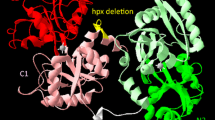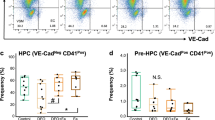Abstract
The objective of the present study was to elucidate the effect of perinatal cobalt chloride (CoCl2) exposure on extramedullary erythropoiesis in suckling mice in relation to iron (Fe) content and transferrin receptor (TfR) expression. Pregnant ICR mice were subjected to a daily dose of 75 mg CoCl2/kg body weight 2–3 days prior and 18 days after delivery. Co exposure significantly increased erythrocyte count (RBC), and reduced the erythrocytic parameters mean corpuscular volume (MCV) and mean corpuscular hemoglobin (MCH) in the offspring. Total iron-binding capacity (TIBC) was decreased while bilirubin values were ~ 1.2-fold higher in the metal-exposed mice. Perinatal CoCl2 treatment also induced pathohistological changes in target organs (spleen, liver, and kidneys) as altered organ weight indices, leukocyte infiltration, abundant Kupffer cells in the liver, increased mesangial cellularity, and reduced capsular space in the kidney. CoCl2 administration induced significant 68-, 3.8-, 41.3-, and 162-fold increase of Co content in the kidney, spleen, liver, and RBC, respectively. Fe content in the target organs of CoCl2-treated mice was also significantly elevated. Immunohistochemical analysis demonstrated that TfR1 was well expressed in the renal tubules, hepatocytes, the red pulp, and marginal zone of white pulp in the spleen. TfR2 showed similar expression pattern, but its expression was stronger in the spleen and liver samples of Co-treated mice compared with that of the untreated controls. The results demonstrate that exposure to CoCl2 during late pregnancy and early postnatal period affects body and organ weights and alters hematological and biochemical parameters, iron content, and TfR expression in target organs.





Similar content being viewed by others
References
Okamoto S, Eltis LD (2011) The biological occurrence and trafficking of cobalt. Metallomics 3:963–970
Diaz RJ, Rosenberg R (2008) Spreading dead zones and consequences for marine ecosystems. Science 321:926–929
Czarnek K, Terpiłowska S, Siwicki AK (2015) Selected aspects of the action of cobalt ions in the human body. Cent Eur J Immunol 40:236–242
Simonsen LO, Harbak H, Bennekou P (2012) Cobalt metabolism and toxicology--a brief update. Sci Total Environ 432:210–215
Sipahi H, Eken A, Aydın A, Şahin G, Baydar T (2014) Safety assessment of essential and toxic metals in infant formulas. Turk J Pediatr 56:385–391
Triantafyllou A, Liakos P, Tsakalof A, Georgatsou E, Simos G, Bonanou S (2006) Cobalt induces hypoxia-inducible factor-1α (HIF-1α) in HeLa cells by an iron-independent, but ROS-, PI-3 K-and MAPK-dependent mechanism. Free Radic Res 40:847–856
Muñoz-Sánchez J, Chánez-Cárdenas ME (2018) The use of cobalt chloride as a chemical hypoxia model. J Appl Toxicol. https://doi.org/10.1002/jat.3749
Unice KM, Kerger BD, Paustenbach DJ, Finley BL, Tvermoes BE (2014) Refined biokinetic model for humans exposed to cobalt dietary supplements and other sources of systemic cobalt exposure. Chem Biol Interact 216:53–74
Bozzini CE, Barrio Rendo ME, Devoto FC, Epper CE (1970) Studies on medullary and extramedullary erythropoiesis in the adult mouse. Am J Physiol 219:724–728
Millot S, Andrieu V, Letteron P, Lyoumi S, Hurtado-Nedelec M, Karim Z, Thibaudeau O, Bennada S, Charrier J-L, Lasocki S, Beaumont C (2010) Erythropoietin stimulates spleen BMP4-dependent stress erythropoiesis and partially corrects anemia in a mouse model of generalized inflammation. Blood 116:6072–6081
Paulson RF, Shib L, Wu D-C (2011) Stress erythropoiesis: new signals and new stress progenitor cells. Curr Opin Hematol 18:139–145
Gluhcheva Y (2016) Transferrin receptors and hematopoiesis. Acta morphol anthropol 23:140–144
Kawabata H (2019) Transferrin and transferrin receptors update. Free Radic Biol Med 133:46–54
Skalny AV, Zaitseva IP, Gluhcheva YG, Skalny AA, Achkasov EE, Skalnaya MG, Tinkov AA (2018) Cobalt in athletes: hypoxia and doping – new crossroads. J Appl Biomed. https://doi.org/10.32725/jab.2018.003
Loréal O, Cavey T, Bardou-Jacquet E, Guggenbuhl P, Ropert M, Brissot P (2014) Iron, hepcidin, and the metal connection. Front Pharmacol 5:128
Illing AC, Shawki A, Cunningham CL, Mackenzie B (2012) Substrate profile and metal-ion selectivity of human divalent metal-ion transporter-1. J Biol Chem 287:30485–30496
Mitchell CJ, Shawki A, Ganz T, Nemeth E, Mackenzie B (2013) Functional properties of human ferroportin, a cellular iron exporter reactive also with cobalt and zinc. Am J Physiol Cell Physiol 306:C450–C459
Garoui el M, Fetoui H, Ayadi Makni F, Boudawara T, Zeghal N (2011) Cobalt chloride induces hepatotoxicity in adult rats and their suckling pups. Exp Toxicol Pathol 63:9–15
Maines MD, Kappas A (1976) Studies on the mechanism of induction of haem oxygenase by cobalt and other metal ions. Biochem J 154:125–131
Nath KA (1999) Heme oxygenase-1: a redoubtable response that limits reperfusion injury in the transplanted adipose liver. J Clin Invest 104:1485–1486
Kasvosve I, Delanghe J (2002) Total iron binding capacity and transferrin concentration in the assessment of iron status. Clin Chem Lab Med 40:1014–1018
Oyagbemi AA, Omobowale TO, Awoyomi OV, Ajibade TO, Falayi OO, Ogunpolu BS, Okotie UJ, Asenuga ER, Adejumobi OA, Hassan FO, Ola-Davies OE, Saba AB, Adedapo AA, Yakubu MA (2018) Cobalt chloride toxicity elicited hypertension and cardiac complication via induction of oxidative stress and upregulation of COX-2/Bax signaling pathway. Hum Exp Toxicol. https://doi.org/10.1177/0960327118812158
Oh SW, Lee Y-M, Kim S, Chin HJ, Chae D-W, Na KY (2014) Cobalt chloride attenuates oxidative stress and inflammation through NF-κB inhibition in human renal proximal tubular epithelial cells. J Korean Med Sci 29(Suppl 2):S139–S145
Awoyemi OV, Okotie UJ, Oyagbemi AA, Omobowale TO, Asenuga ER, Ola-Davies OE, Ogunpolu BS (2017) Cobalt chloride exposure dose-dependently induced hepatotoxicity through enhancement of cyclooxygenase-2 (COX-2)/B-cell associated protein X (BAX) signaling and genotoxicity in Wistar rats. Environ Toxicol 32:1899–1907
Minior VK, Levine B, Ferber A, Guller S, Divon MY (2017) Nucleated red blood cells as a marker of acute and chronic fetal hypoxia in a rat model. Rambam Maimonides Med J. https://doi.org/10.5041/RMMJ.10302
Wolman M, Cervós-Navarro J, Sampaolo S, Cardesa A (1993) Pathological changes in organs of rats chronically exposed to hypoxia. Development of pulmonary lipidosis. Histol Histopathol 8:247–255
Gluhcheva Y, Atanasov V, Ivanova J, Mitewa M (2012) Cobalt-induced changes in the spleen of mice from different stages of development. J Toxicol Environ Health A 75:1418–1422
Chien CH, Hwu CM, Liou TL, Huang ZL, Shen AR, Yang VH, Lee CW, Chien EJ (2006) Inducible nitric oxide synthase expression and plasma bilirubin changes in rats under intermittent hypoxia treatment. Chin J Physiol 49:275–280
Losco P Mohr U, Dungworth DL (1992) Capen CC Normal development, growth, and aging of the spleen. Pathobiology of the aging rat. ILSI Press, Washington, DC, p 7594
Cinar N, Ozdemir S, Yucel O, Ucar F (2011) In which regions is breast-feeding safer from the impact of toxic elements from the environment? Bosn J Basic Med Sci 11:234–239
Wappelhorst O, Kühn I, Heidenreich H, Markert B (2002) Transfer of selected elements from food into human milk. Nutrition 18:316–322
Nicolas G, Chauvet C, Viatte L, Danan JL, Bigard X, Devaux I, Beaumont C, Kahn A, Vaulont S (2002) The gene encoding the iron regulatory peptide hepcidin is regulated by anemia, hypoxia, and inflammation. J Clin Invest 110:1037–1044
Liu Q, Davidoff O, Niss K, Haase VH (2012) Hypoxia-inducible factor regulates hepcidin via erythropoietin-induced erythropoiesis. J Clin Invest 122(12):4635–4644
Ganz T, Nemeth E (2012) Hepcidin and iron homeostasis. Biochim Biophys Acta 1823:1434–1443
Drakesmith H, Nemeth E, Ganz T (2015) Ironing out ferroportin. Cell metab 22:777–787
Cesta M (2006) Normal structure, function, and histology of the spleen. Toxicol Pathol 34:455–465
Kim C (2010) Homeostatic and pathogenic extramedullary hematopoiesis. J Blood Med 1:13–19
Bishop GM, Smith MA, LaManna JC, Wilson AC, Perry G, Atwood CS (2007) Iron homeostasis is maintained in the brain, but not the liver, following mild hypoxia. Redox Report 12:257–266
Stutte HJ, Sakuma T, Falk S, Schneider M (1986) Splenic erythropoiesis in rats under hypoxic and post-hypoxic conditions. Virchows Arch A Pathol Anat Histol 409:251–261
Goetze O, Schmitt J, Spliethoff K, Theurl I, Weiss G, Swinkels DW et al (2013) Adaptation of iron transport and metabolism to acute high altitude hypoxia in mountaineers. Hepatology 58:2153–2162
Lu JP, Hayashi K, Awai M (1989) Transferrin receptor expression in normal, iron-deficient and iron-overloaded rats. Acta Pathol Jpn 39:759–764
Rishi G, Secondes ES, Wallace DF, Subramaniam VN (2016) Hematopoietic deletion of transferrin receptor 2 in mice leads to a block in erythroid differentiation during iron-deficient anemia. Am J Hematol 91:812–818
Wallace DF, Secondes ES, Rishi G, Ostini L, McDonald CJ, Lane SW, Vu T, Hooper JD, Velasco G, Ramsay AJ, Lopez-Otin C, Subramaniam VN (2015) A critical role for murine transferrin receptor 2 in erythropoiesis during iron restriction. Br J Haematol 168:891–901
Funding
The study was supported by Grant No. DNTS/Russia 02/1/14.06.2018 from the Bulgarian National Science Fund and No. 18-54-18006 from the Russian Foundation for Basic Research.
Author information
Authors and Affiliations
Corresponding author
Ethics declarations
This experimental design was carried out in accordance with the guidelines of EU Directive 2010/63/EU for animal experiments. All applicable international, national, and/or institutional guidelines for the care and use of animals were followed.
Conflict of Interest Statement
The authors declare that they have no conflict of interest.
Additional information
Publisher’s Note
Springer Nature remains neutral with regard to jurisdictional claims in published maps and institutional affiliations.
Rights and permissions
About this article
Cite this article
Gluhcheva, Y., Pavlova, E., Petrova, E. et al. The Impact of Perinatal Cobalt Chloride Exposure on Extramedullary Erythropoiesis, Tissue Iron Levels, and Transferrin Receptor Expression in Mice. Biol Trace Elem Res 194, 423–431 (2020). https://doi.org/10.1007/s12011-019-01790-8
Received:
Accepted:
Published:
Issue Date:
DOI: https://doi.org/10.1007/s12011-019-01790-8




